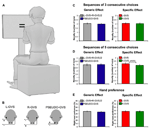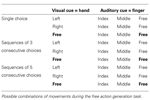Ferrè, ER;
Arthur, K;
Haggard, P;
(2013)
Galvanic vestibular stimulation increases novelty in free selection of manual actions.
Frontiers in Integrative Neuroscience
, 7
, Article 74. 10.3389/fnint.2013.00074.

Preview |
PDF
fnint-07-00074.pdf Download (968kB) |
![[thumbnail of JPG FIGURE 1. Effects of GVS on spatial bias and novelty.]](https://discovery.ucl.ac.uk/1421177/2.hassmallThumbnailVersion/fnint-07-00074-g001.gif)  Preview |
Other (JPG FIGURE 1. Effects of GVS on spatial bias and novelty.)
fnint-07-00074-g001.gif Download (9kB) |
![[thumbnail of JPG TABLE 1. Experimental conditions in the free action generation task.]](https://discovery.ucl.ac.uk/1421177/3.hassmallThumbnailVersion/fnint-07-00074-t001.gif)  Preview |
Other (JPG TABLE 1. Experimental conditions in the free action generation task.)
fnint-07-00074-t001.gif Download (5kB) |
![[thumbnail of JPG TABLE 2. Mean scores in each stimulation condition. ]](https://discovery.ucl.ac.uk/1421177/4.hassmallThumbnailVersion/fnint-07-00074-t002.gif)  Preview |
Other (JPG TABLE 2. Mean scores in each stimulation condition. )
fnint-07-00074-t002.gif Download (2kB) |
Abstract
Making optimal choices in changing environments implies the ability to balance routine, exploitative patterns of behavior with novel, exploratory ones. We investigated whether galvanic vestibular stimulation (GVS) interferes with the balance between exploratory and exploitative behaviors in a free action selection task. Brief right-anodal and left-cathodal GVS or left-anodal and right-cathodal GVS were delivered at random to activate sensorimotor circuits in the left and right hemisphere, respectively. A sham stimulation condition was included. Participants endogenously generated sequences of possible actions, by freely choosing successive movements of the index or middle finger of the left or right hand. Left-anodal and right-cathodal GVS, which preferentially activates the vestibular projections in the right cerebral hemisphere, increased the novelty in action sequences, as measured by the number of runs in the sequences. In contrast, right-anodal and left-cathodal GVS decreased the number of runs. There was no evidence of GVS-induced spatial bias in action choices. Our results confirm previous reports showing a polarity-dependent effect of GVS on the balance between novel and routine responses, and thus between exploratory and exploitative behaviors.
| Type: | Article |
|---|---|
| Title: | Galvanic vestibular stimulation increases novelty in free selection of manual actions |
| Location: | Switzerland |
| Open access status: | An open access version is available from UCL Discovery |
| DOI: | 10.3389/fnint.2013.00074 |
| Publisher version: | http://dx.doi.org/10.3389/fnint.2013.00074 |
| Language: | English |
| Additional information: | PMCID: PMC3817628 This is an open-access article distributed under the terms of the Creative Commons Attribution License[http://creativecommons.org/licenses/by/4.0/], which permits unrestricted use, distribution, and reproduction in any medium, provided the original author and source are credited. |
| Keywords: | action selection, exploitation, exploration, galvanic vestibular stimulation, hemispheric specialization, novelty |
| UCL classification: | UCL UCL > Provost and Vice Provost Offices UCL > Provost and Vice Provost Offices > School of Life and Medical Sciences UCL > Provost and Vice Provost Offices > School of Life and Medical Sciences > Faculty of Brain Sciences UCL > Provost and Vice Provost Offices > School of Life and Medical Sciences > Faculty of Brain Sciences > Div of Psychology and Lang Sciences UCL > Provost and Vice Provost Offices > School of Life and Medical Sciences > Faculty of Brain Sciences > Div of Psychology and Lang Sciences > Institute of Cognitive Neuroscience |
| URI: | https://discovery.ucl.ac.uk/id/eprint/1421177 |
Archive Staff Only
 |
View Item |


